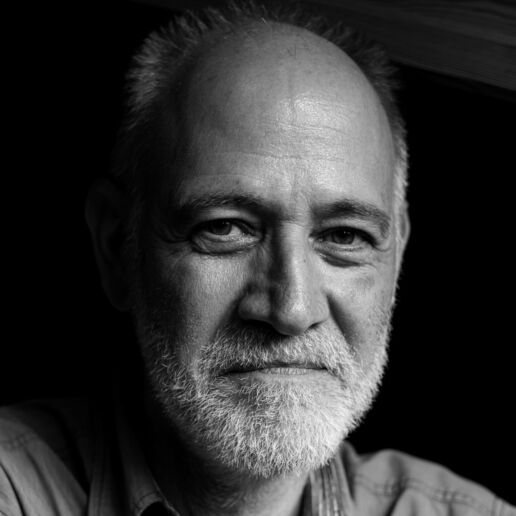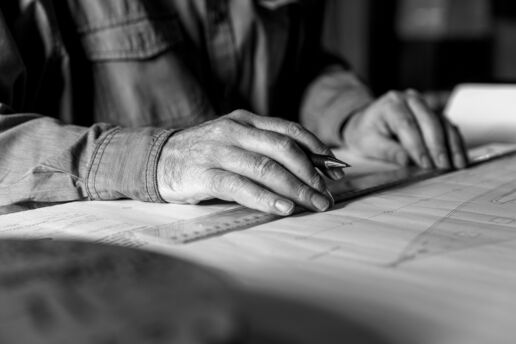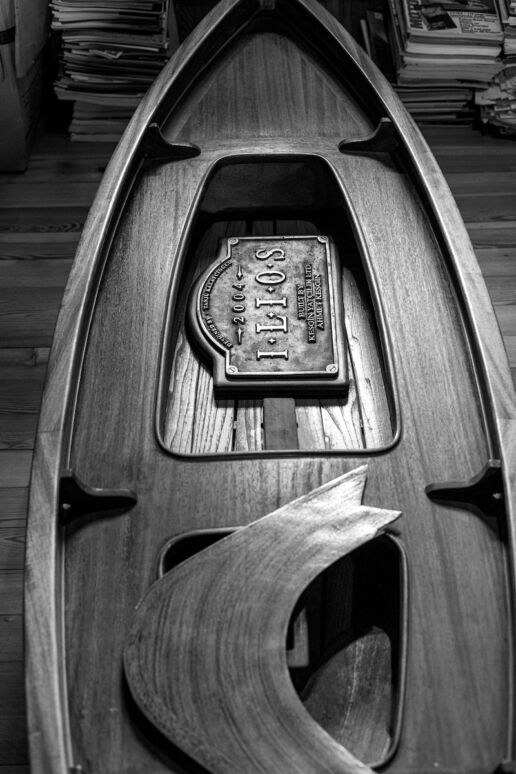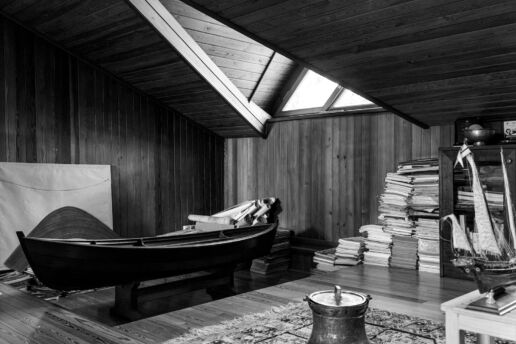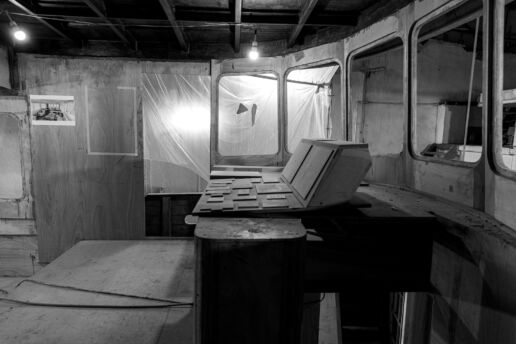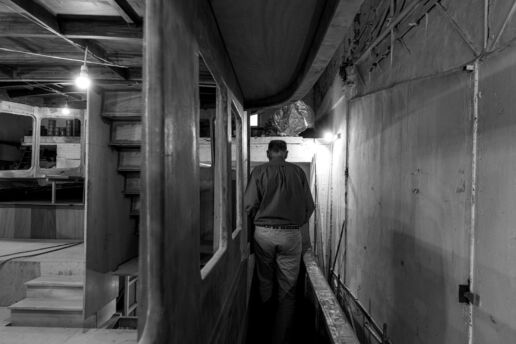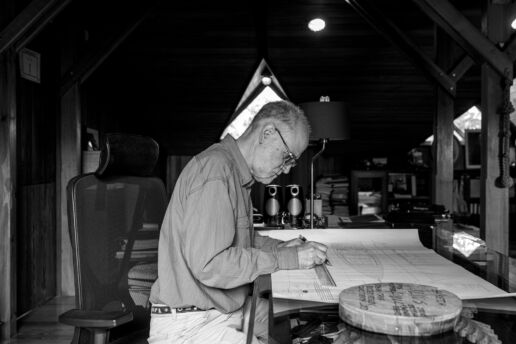TANJU KALAYCIOĞLU
Listening to people who lived in Istanbul before my time intrigues me. Imagining people swimming happily in the sea sounds like a fairy tale. I find it hard to relate to the idea that there was once no bridge spanning the continents. I like talking to people whose family members have streets named after them. It's like a mediator; it makes you realize how life was just a few decades ago. Immersed in such thoughts, we prepare to dig deeper into one of these stories unique to Istanbul. We are off to Tuzla on the Asian side of the city to meet Osman Tanju Kalaycıoğlu, one of Turkey’s leading yacht designers who has earned international acclaim. His company, Taka Yacht Design, is the name behind state-of-the-art yachts custom-made for the likes of Johnny Depp and Flavio Briatore. Here is his story.Photography Nazlı Erdemirel
TO SUADIYE, WITH THE WHOLE ENTOURAGE
PAPER: I know you spent your childhood in Suadiye. Can you tell us about the Suadiye of your childhood? What was life like?
Tanju Kalaycıoğlu: Actually, I grew up in Topağacı on the European side and lived there until 1999. The house in Suadiye was our summer house at first. It belonged to Atatürk’s aide Salih Bozok, before my grandfather bought it in 1936. It was a seafront house with a big garden and six bedrooms on the top floor. We used to gather several families there. I don’t remember much about my grandfather because he died young in a traffic accident. My grandmother and uncle would often join us in this house. Their flat was also outstanding – Şişli Palas, the most spectacular apartment in the district and just a few blocks away from Atatürk’s residence. In summer, life was communal with my aunt, uncle, and their two children, my mother and father and their three children, the employees, the gardener, and our family. The Bosporus Bridge did not open until 1973. Mattresses and other essentials were loaded onto the pick-up. From there, we would drive to Kabataş to catch the ferry to Suadiye. I loved being in a crowded house.
P: Can you tell us about life on the seaside in Suadiye in those years?
TK: My father and mother would go fishing while she was still pregnant with me. They dropped lobster baskets into the sea and would later find them by bearings. Locating the intersection of three trajectories, they could identify their baskets and reel them in. A dirt road next to our house ended on the beach. Children from the Black Sea region would come each summer and build shacks at the end of the road. They used to get water from our garden. In later years, my father provided them with electricity so they could light a few bulbs. My father’s side is from Trabzon, and he somehow felt he needed to look out for those kids who tried to earn a living by renting small rowboats. They even placed buoys offshore, providing a makeshift mooring facility for boats. A couple of times every summer, a strong southwesterly wind would blow, and all boats would be washed ashore in front of us. Then, the locals would gather to try to pull them back to the sea, sometimes working late into the night. The word ‘yacht’ was not known back then. Sailing boats were called ‘cutters’. Faster, motorized boats were called ‘Chris Craft,’ which was, in fact, the name of an American boat builder. We started swimming a little further away after the sewage from a growing number of apartments started being discharged into the shallow Suadiye Sea. Most of the places I mentioned are now buried under the coastal road. The sea became polluted, and this way of life was over once the new road was built.
A BOAT TRIP TO THE PRINCE’S ISLANDS
P: I imagine you started going to the Prince’s Islands when the sea in Suadiye got polluted. I know that your father was one of the founders of the Suadiye Sailing Club…
TK: Yes. We had a boat. Everyone would clamber on it and try to find a place for themselves. (Laughs.) We first stopped at Kaşık Island for a swim. Depending on the weather, we would anchor in Çamlimanı to have our sandwiches. Sometimes, we stopped at Büyükada, where we occasionally got some ice cream. When the northerly winds picked up, and the sea became a little rough, we would go down to Dragos to swim. My father founded the club with his sailor friends and brothers in 1971. They called it Suadiye Yacht Club at the time. I was about ten years old when my father ordered an optimist sailboat made of plywood for me. The mast was made of pine, the sail made of thick cotton canvas, and the cotton ropes… Then he brought me a more modern sheet set from Germany. The club in Suadiye had a name, but nothing was being done. So, I founded the Tuzla Sailing and Water Sports Club with my friends in Tuzla. I don’t know of any other family whose father and son founded their own sailing club.
MİM KEMAL ÖKE AND HÜSREV GEREDE
P: Two streets in Nişantaşı are named after people from your mother’s side. Who were they?
TK: My grandmother’s father was Mim Kemal Öke, a military doctor. He went to join the war in Libya alongside Ataturk. There are many stories about him. From what I’m told, it was impossible to disinfect hands before surgery under those conditions. It seems they had to dip their hands into some liquid, which was bad for the skin. Of course, there were latex gloves back then. In time, his fingers started to rot, and they had to be amputated. When the time came to amputate his last finger, he asked one of his renowned assistants, Halit Ziya Konuralp, to remove it under general anesthesia, but unfortunately, he did not survive. They had a beautiful apartment on Valikonağı Street. My grandmother and grandfather used to stay there when they visited Istanbul. My grandfather was working in Switzerland. He was sent to a boarding school for junior education in Hamburg. There is a photo of him taken before the First World War, in which he is at the reception ceremony of one of our submarines bearing a Turkish flag in Bremen or Hamburg. Hüsrev Gerede is a distant relative on my mother’s side. His wife is my grandfather’s cousin. He was one of Atatürk’s few advocates at the Erzurum Congress. I remember their house was full of katanas and Japanese swords because he was the Turkish ambassador to Tokyo.
P: What do you recall from your time living in Topağacı?
TK: There was a little stationary shop called ‘Küçük Adam (Little Man)’ on the road from Topağacı to Teşvikiye Police Station. I would go there regularly to buy Doğan Kardeş magazine. It was a magazine dedicated by the Founder of Yapı Kredi Bank to his deceased son. Years later, I met Karaca Taşkent, Doğan’s brother, at a sailing event. Mr. Karaca is still a close family friend. I have to add another thing: I went to Maçka Primary School. I came from a privileged family, but our teachers there were outstanding. The main reason we got into elite schools like Robert College were those state school teachers.
A PASSION FOR WOOD
P: You studied Ship Sciences in England but chose to return and work here. What was in Istanbul that wasn’t there?
TK: Above all, it was my loving family. I didn’t want to leave them. On my return, I stayed with my parents instead of renting a flat. There, I focused on starting a business. Moreover, England was downsizing its heavy industries in the early 80s. Thatcher’s policies, in particular, were forcing mines, car factories, steel factories, and shipyards to shut down amidst massive strikes.
The future was bleak in England, mainly because of high labor costs. Of course, Istanbul’s nature is second to none. There are rivers in London or Paris, but they are nowhere near as nice as Istanbul. Sydney probably comes closest to Istanbul as a metropolis where life is intertwined with waterways.
P: You prefer a classical style using wood and hand drawings in your work. Your office is similar. What about your home?
TK: At work, a classic style does not involve antique or replica boats. They are completely original designs. The woodwork is very contemporary. We use the strengths of wood and mitigate its weaknesses as a material. The architects of my house are the famous couple Behruz and Altuğ Çinici. The owner of the house was Kemal Kurdaş. Both the architects and the previous owner are Aga Khan Award winners. Kurdaş was the rector of Middle East Technical University when he conducted a forestation project with the students. Years later, a book was written about the fauna inhabiting that reforested hill. That’s what brought him the award. Behruz received an award for designing the mosque of the Turkish Grand National Assembly. My house was Kurdaş’s summer house in Tuzla. I admit I’m very meticulous. That was the first house I saw, and I bought it immediately. It looked like a simple two-story house, but I could feel that an architect had spent time thinking and calculating. I would not categorize my house or office as classic, but the quality of the woodwork is superior.
“THERE ARE STILL PLACES TO DISCOVER IN ISTANBUL”
P: Finally, are there other neighborhoods in Istanbul that you enjoy or visit to relax or find inspiration?
TK: I like Spice Bazaar and Cağlaoğlu Slope. We had built a limousine tender for the Peninsula Hotel. I was taking the hotel managers on a Bosporus tour on one of our boats, which also sailed into the Golden Horn. I felt nostalgic. I did my military service at Taşkızak Shipyard. It was a sad sight to see. After taking Istanbul from the Byzantines, Mehmet II ‘The Conqueror’ reserved the area between Kasımpaşa and Perşembe Pazarı for the navy: Taşkızak Shipyard, Hasköy Shipyard, Camialtı Shipyard and Haliç Shipyard. Now, the only active one is Haliç… My relative, Sinan Sinangil, who owns Sinangil Flour Mills, built a Swiss chalet-style house in Polonezköy. He also brought his horses from Konya there. We went there for years. The nature was just so lovely. From Polonezköy, we would go to Riva. There was a man called Abbas. He was one of the grandchildren of the Egyptian Khedives. We would sit down with him to discuss philosophy. If you had seen him on the street, you would have thought he was a beggar, but he spoke English like an aristocrat because he had taken lessons from private teachers in London. His older brother, Halim, had boats drawn and built by Harun Ülman, one of the founders of the Istanbul Sailing Club. It was amazing. Now, Riva is full of villas, and this bothers me. Suadiye is no different… I know Istanbul still has places to explore, but I choose not to. Aren’t we all like this?


